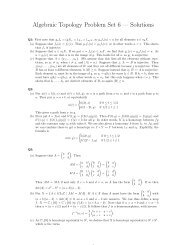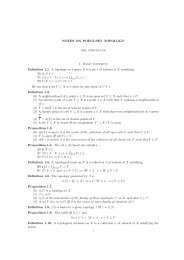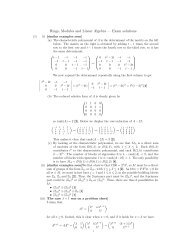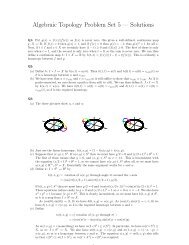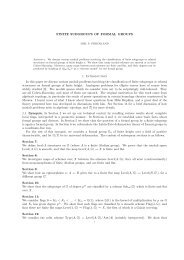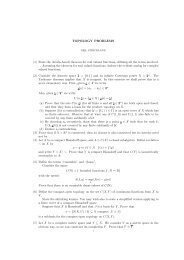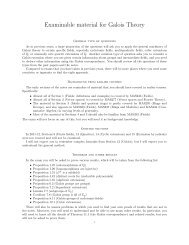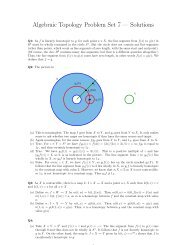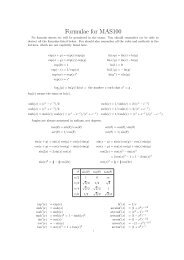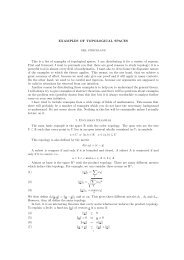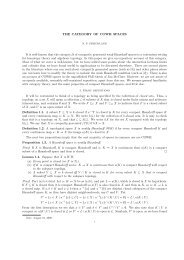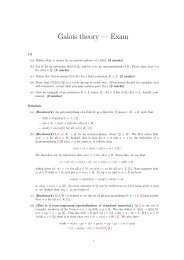fields and galois theory - Neil Strickland - University of Sheffield
fields and galois theory - Neil Strickland - University of Sheffield
fields and galois theory - Neil Strickland - University of Sheffield
Create successful ePaper yourself
Turn your PDF publications into a flip-book with our unique Google optimized e-Paper software.
Corollary 8.8. [cor-F-additive]<br />
If g(t) ∈ Z[t] then g(t p ) = g(t) p (mod p).<br />
Pro<strong>of</strong>. We can write g(t) = ∑ d<br />
i=0 a it i with a i ∈ Z. The lemma tells us that the p’th power operation<br />
commutes with addition modulo p, so g(t) p = ∑ d<br />
i=0 ap i tip (mod p). The lemma also tells us that a p i = a i<br />
(mod p), so g(t) p = ∑ d<br />
i=0 a it ip (mod p), <strong>and</strong> this is just the same as g(t p ). □<br />
Lemma 8.9. [lem-zeta-p]<br />
Let ζ be an element <strong>of</strong> µ × n , <strong>and</strong> put f(t) = min(ζ, Q). Let p be a prime that does not divide n. Then<br />
f(ζ p ) = 0.<br />
Pro<strong>of</strong>. As ζ is a root <strong>of</strong> t n − 1 we see that f(t) divides t n − 1, say t n − 1 = f(t)g(t) for some (necessarily<br />
monic) polynomial g(t) ∈ Q[t]. We see from Proposition 4.21 that in fact f(t), g(t) ∈ Z[t].<br />
Next, we can use the equation ζ n = 1 to see that (ζ p ) n − 1 = 0, or equivalently f(ζ p )g(ζ p ) = 0. If we can<br />
show that g(ζ p ) ≠ 0 then we conclude that f(ζ p ) = 0 as required.<br />
We therefore assume that g(ζ p ) = 0, <strong>and</strong> try to derive a contradiction. Note that g(t p ) is a polynomial in<br />
Z[t] that is zero when t = ζ. It therefore follows from the definition <strong>of</strong> f(t) = min(ζ, Q) that g(t p ) is divisible<br />
by f(t), say g(t p ) = f(t)h(t). We can again use Proposition 4.21 to see that h(t) ∈ Z[t].<br />
We next need to work temporarily modulo p. For any polynomial m(t) ∈ Z[t], we will write m(t) for<br />
the image <strong>of</strong> m(t) in F p [t]. The equation g(t p ) = f(t)h(t) in conjunction with Corollary 8.8 tells us that<br />
g(t) p = f(t)h(t). Now let k(t) be any monic irreducible factor <strong>of</strong> f(t) in F p [t]. We then see that k(t)<br />
divides g(t) p , so (by irreducibility) it must divide g(t). It follows that k(t) 2 divides f(t)g(t) = t n − 1, say<br />
t n − 1 = k(t) 2 m(t) for some m(t) ∈ F p [t]. We then take the algebraic derivative to see that<br />
n t n−1 = 2k(t)k ′ (t)m(t) + k(t) 2 m ′ (t) = (2k ′ (t)m(t) + k(t)m ′ (t))k(t)<br />
so in particular k(t) divides n t n−1 . Note here that n ≠ 0 in F p (because we assumed that p does not divide<br />
n) <strong>and</strong> that k(t) was assumed to be monic <strong>and</strong> irreducible. It is clear from this that we must have k(t) = t,<br />
so k(0) = 0. We can thus put t = 0 in the equation t n − 1 = k(t) 2 m(t) to get −1 = 0 (mod p), which is the<br />
required contradiction.<br />
□<br />
Corollary 8.10. [cor-cyclotomic-roots]<br />
Let ζ be an element <strong>of</strong> µ × n , <strong>and</strong> put f(t) = min(ζ, Q). Let k be any integer that is coprime to n. Then<br />
f(t) = min(ζ k , Q) (<strong>and</strong> so f(ζ k ) = 0).<br />
Pro<strong>of</strong>. If k is prime, then the lemma tells us that f(ζ k ) = 0. It follows that min(ζ k , Q) is a non-constant<br />
monic divisor <strong>of</strong> the irreducible polynomial f(t), so it must just be equal to f(t) as required.<br />
Now suppose that k = pq for some primes p <strong>and</strong> q (which cannot divide n, because k is coprime to n). By<br />
the prime case (applied to ζ <strong>and</strong> p) we see that f(t) = min(ζ p , Q). We can therefore apply the prime case<br />
again to ζ p <strong>and</strong> q to see that f(t) = min(ζ pq , Q) = min(ζ k , Q). In general, if k > 0 <strong>and</strong> k is coprime to n<br />
then we can write k = p 1 p 2 · · · p r for some primes p 1 , . . . , p r (not necessarily distinct) that do not divide n.<br />
We then see that f(t) = min(ζ k , Q) by an obvious extension <strong>of</strong> the argument for the case k = pq. Finally, if<br />
k < 0 <strong>and</strong> (k, n) = 1 then we can choose j such that the number k ′ = k + jn is positive (<strong>and</strong> still coprime<br />
to n). We then see that f(t) = min(ζ k′ , Q) but ζ k′ = (ζ n ) j ζ k = ζ k so f(t) = min(ζ k , Q) as claimed. □<br />
Pro<strong>of</strong> <strong>of</strong> Proposition 8.6. Put ζ = exp(2πi/n) ∈ µ × n , <strong>and</strong> f(t) = min(ζ, Q). As ϕ n (ζ) = 0 we see that f(t)<br />
divides ϕ n (t). On the other h<strong>and</strong>, the roots <strong>of</strong> ϕ n (t) are precisely the elements <strong>of</strong> µ × n , or in other words the<br />
powers ζ k with 0 ≤ k < n <strong>and</strong> (k, n) = 1. Corollary 8.10 tells us that these are also roots <strong>of</strong> f(t), so ϕ n (t)<br />
divides f(t) by Proposition 4.29. As f(t) <strong>and</strong> ϕ n (t) are monic polynomials that divide each other, we must<br />
have ϕ n (t) = f(t). As f(t) is irreducible by definition, we see that ϕ n (t) is irreducible as claimed. □<br />
Proposition 8.11. [prop-cyclotomic-<strong>galois</strong>]<br />
For each k ∈ Z that is coprime to n there is a unique automorphism σ k <strong>of</strong> Q(µ n ) such that σ k (ζ) = ζ k for<br />
all ζ ∈ µ n . Moreover, the rule k + nZ ↦→ σ k gives an isomorphism <strong>of</strong> groups (Z/nZ) × → G(Q(µ n )/Q).<br />
Pro<strong>of</strong>. Put ζ 1 = exp(2πi/n) ∈ µ × n ; we have seen that ϕ n (x) = min(ζ 1 , Q). Now suppose we have k ∈ Z such<br />
that (k, n) = 1. Then ζ1<br />
k ∈ µ × n , so ϕ n (ζ 1 ) = 0. It then follows from Proposition 6.17(c) that there is an<br />
44




